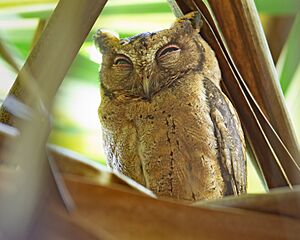Sunda scops owl facts for kids
Quick facts for kids Sunda scops owl |
|
|---|---|
 |
|
| In Singapore. | |
| Conservation status | |
| Scientific classification | |
| Genus: |
Otus
|
| Species: |
lempiji
|
The Sunda scops owl (Otus lempiji) is a small brown owl. It lives naturally on the Sunda Islands and nearby areas.
Contents
About the Sunda Scops Owl
The Sunda scops owl is a small bird. It grows to be about 20 to 25 centimeters (8 to 10 inches) tall. It usually weighs between 100 to 170 grams (3.5 to 6 ounces).
This owl has black speckles on its upper body. Its lower body has black streaks. It also has a light-colored collar around its neck. Its dark eyes help tell it apart from other similar owls. These include the reddish scops, mountain scops, Oriental scops, and Rajah scops owls.
Where It Lives
You can find the Sunda scops owl in several places. These include the Malay Peninsula, Singapore, Borneo, Sumatra, and Java.
It mostly lives in forests and gardens. Sometimes, it might even be seen near buildings. This shows how well it can adapt to different places.
What It Eats
The Sunda scops owl mainly eats insects. It also hunts small animals for food.
Some of its favorite meals are rats, small fish, and lizards. It also enjoys eating crickets and beetle larvae. Rats are its most preferred prey.
Reproduction and Family Life
The Sunda scops owl builds its nest using plant fibers. It lays up to three eggs in a tree hollow. This usually happens between January and April. Sometimes, their breeding season can last until June or even late July.
These owls can be quite protective of their homes. If another owl threatens them, they might act aggressively. Female owls will make loud calls to warn intruders. This helps keep other animals away from their nest and young.
Owl Calls and Sounds
The Sunda scops owl has a special call. It sounds like a hooting yelp, with long quiet periods in between. These owls use their calls to mark their territory.
Each owl has a unique voice. They make calls at different sound frequencies. This makes it easier for each owl to stand out. Having a unique voice helps them claim their territory more effectively.
Conservation Status
The Sunda scops owl is listed as a "least concern species" on the IUCN Red List. This means it is common in areas where it has good habitat. It is not currently considered to be in danger of disappearing.
Images for kids
-
Historic (c. 1938) image of an adult with two young, Dampar, East Java.




